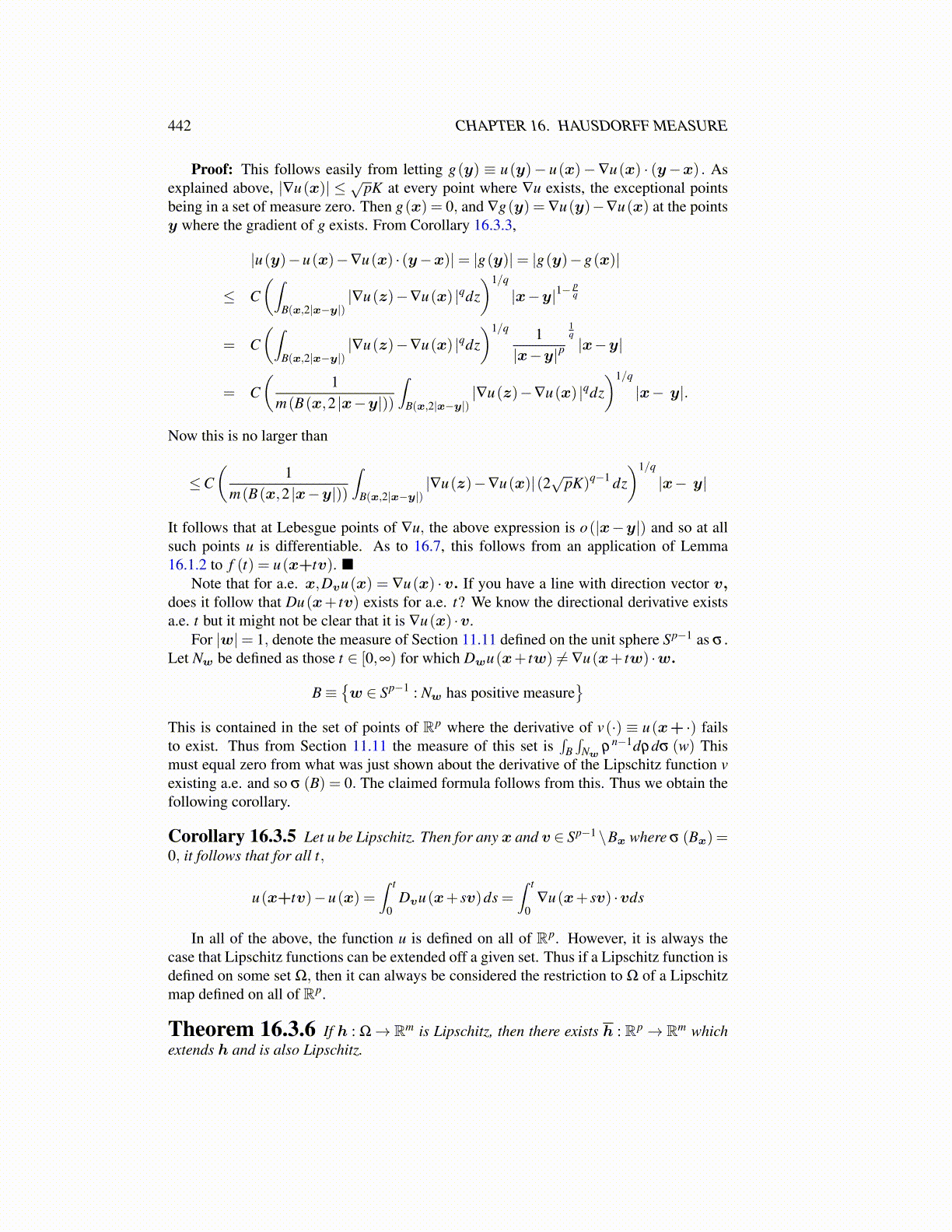
442 CHAPTER 16. HAUSDORFF MEASURE
Proof: This follows easily from letting g(y) ≡ u(y)− u(x)−∇u(x) · (y−x) . Asexplained above, |∇u(x)| ≤ √pK at every point where ∇u exists, the exceptional pointsbeing in a set of measure zero. Then g(x) = 0, and ∇g(y) = ∇u(y)−∇u(x) at the pointsy where the gradient of g exists. From Corollary 16.3.3,
|u(y)−u(x)−∇u(x) · (y−x)|= |g(y)|= |g(y)−g(x)|
≤ C(∫
B(x,2|x−y|)|∇u(z)−∇u(x) |qdz
)1/q
|x−y|1−pq
= C(∫
B(x,2|x−y|)|∇u(z)−∇u(x) |qdz
)1/q 1|x−y|p
1q|x−y|
= C(
1m(B(x,2 |x−y|))
∫B(x,2|x−y|)
|∇u(z)−∇u(x) |qdz)1/q
|x− y|.
Now this is no larger than
≤C(
1m(B(x,2 |x−y|))
∫B(x,2|x−y|)
|∇u(z)−∇u(x)|(2√pK)q−1 dz)1/q
|x− y|
It follows that at Lebesgue points of ∇u, the above expression is o(|x−y|) and so at allsuch points u is differentiable. As to 16.7, this follows from an application of Lemma16.1.2 to f (t) = u(x+tv). ■
Note that for a.e. x,Dvu(x) = ∇u(x) ·v. If you have a line with direction vector v,does it follow that Du(x+ tv) exists for a.e. t? We know the directional derivative existsa.e. t but it might not be clear that it is ∇u(x) ·v.
For |w|= 1, denote the measure of Section 11.11 defined on the unit sphere Sp−1 as σ .Let Nw be defined as those t ∈ [0,∞) for which Dwu(x+ tw) ̸= ∇u(x+ tw) ·w.
B≡{w ∈ Sp−1 : Nw has positive measure
}This is contained in the set of points of Rp where the derivative of v(·) ≡ u(x+ ·) failsto exist. Thus from Section 11.11 the measure of this set is
∫B∫
Nwρn−1dρdσ (w) This
must equal zero from what was just shown about the derivative of the Lipschitz function vexisting a.e. and so σ (B) = 0. The claimed formula follows from this. Thus we obtain thefollowing corollary.
Corollary 16.3.5 Let u be Lipschitz. Then for any x and v ∈ Sp−1 \Bx where σ (Bx) =0, it follows that for all t,
u(x+tv)−u(x) =∫ t
0Dvu(x+ sv)ds =
∫ t
0∇u(x+ sv) ·vds
In all of the above, the function u is defined on all of Rp. However, it is always thecase that Lipschitz functions can be extended off a given set. Thus if a Lipschitz function isdefined on some set Ω, then it can always be considered the restriction to Ω of a Lipschitzmap defined on all of Rp.
Theorem 16.3.6 If h : Ω→ Rm is Lipschitz, then there exists h : Rp→ Rm whichextends h and is also Lipschitz.